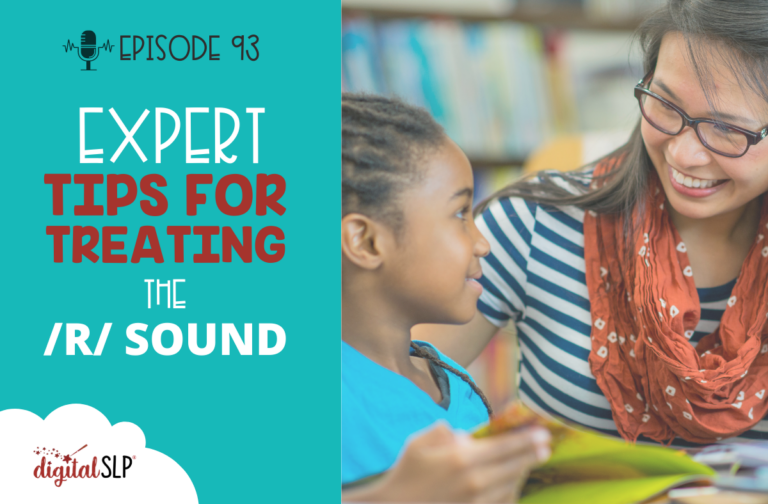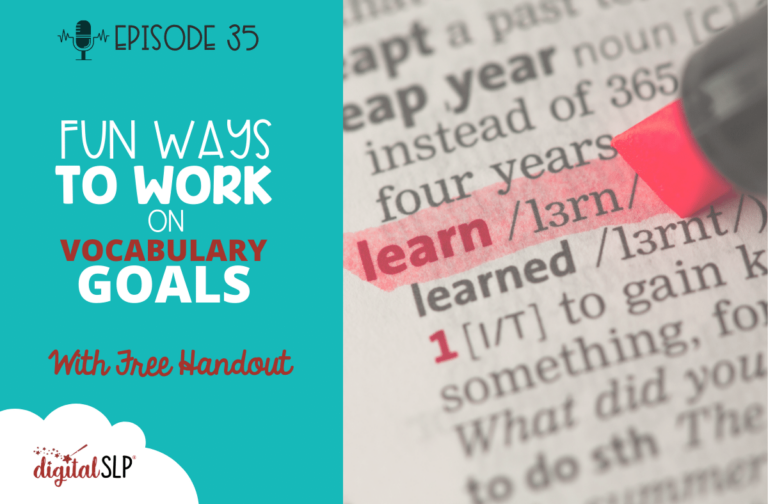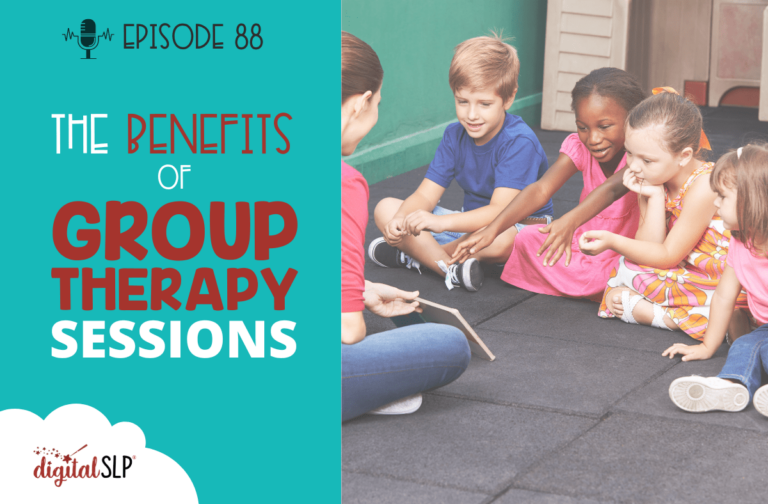The /r/ sound can be tricky to work with, but there are so many ways that we can address it! Often times, it’s just all about finding the right approach that works best for your student. In today’s episode, I cover various ways that you can work on the /r/ sound and hopefully will provide you with some new strategies for your SLP tool box.
Although the /r/ sound is typically acquired by 5-6 years of age, in reality, this is not always the case. There are cases of students age 8 or older not having mastered the /r/ sound. /r/ sound can develop at different stages and times and treating it can be tricky but doesn’t have to be. There’s no right or wrong way but we will be discussing some of the strategies in this episode.
Different strategies and expert tips in treating the /r/ sound:
One Allophone at a Time
Getting a good grasp on in which context that /r/ sound is misarticulated. A good R screener helps assess the /r/ in different distinct allophone combinations. For example:
- AR as in car
- EAR as in near
- ER as in butter
Once an assessment has been done, you can determine which sounds the students might already have and can build on those they need help with. Choosing a proper target helps reduce frustration as it can take several sessions to break through.
Transition Movements
According to Pam Marshalla, it helps to think about prevocalic or postvocalic /r/ alongside its preceding vowel sound. To put this in practice, choose words that end in R and ask the client to remove the R to focus on the vowel, so the client can focus on the motor plan for the preceding CV cluster. For example, star becomes ‘sta’. To effectively do this, you must add the r back slowly using the proper cueing hierarchy.
The Butterfly Effect
Many SLPs write about the success they have had with their clients’ targeting /r/ using the ‘Butterfly Effect’. I will touch on briefly on Angela Jordan’s process. Another way to reinforce this would be to use visual or tactile reinforcers, such as a mirror or tongue depressor to show the client the proper placement.
Bite Blocks
This can be controversial for some. According to Julie Hoffman M.A. CCC-SLP, bite blocks help facilitate the proper oral motor positioning for eliciting /r/. According to Hoffman, one can “eliminate lip rounding by having the client smile during /r/ productions. One could also place a small bite block between the lips while smiling, as the bite block will fall out if the lips are rounded.” Lip rounding during the production of the /r/ sound distorts the intended phoneme because the mouth needs to be open to properly produce it.
Encourage Self-Monitoring
One of the hardest aspects of targeting /r/ is that the client oftentimes doesn’t even realize they’re mispronouncing anything. The client has habituated a sound in place of /r/ that is easier so that discriminating between what is a correct and what is an incorrect /r/ sound is vital to their success in therapy. Pam Marshalla explains that as clinicians, we should be rewarding our clients for ‘listening to themselves to determine how well they did.” This provides the client with the autonomy they need to produce the /r/ sound correctly and independently!
I will also be sharing a few more tips for treating the /r/ sound from an old worksheet I had from graduate school. So be sure to check out my podcast.
R sound is tricky and can be discouraging. I hope you found some of these strategies to be helpful. Hang on and keep trying!
References and resources:
- https://www.sayitright.org/R_Phonetic_Consistency.html
- https://pammarshalla.com/mastering-vocalic-r/
- https://www.electronic-therapy.com/blog/articulation-strategies-and-tips-for-the-r-sound/
- https://www.speechpathology.com/ask-the-experts/developmental-milestones-and-communication-strategies-917
- https://pammarshalla.com/struggling-with-r-training-auditory-self-monitoring/
- The Digital SLP’s FREE sampler resource library
- The Digital SLP’s Teachers Pay Teachers Store
- Sign up for a free trial or sign up
Full Transcript of Podcast: Expert Tips for Treating the /R/ Sound
Episode 93: Expert Tips for Treating the /R/ Sound
You're listening to the Speech Space Podcast, a podcast full of tips and resources for SLPs. I'm your host, Jessica Cassity, and this is Episode 93.
Hey there! Today, we are going to be discussing some expert tips for targeting the /r/ sound in articulation therapy. Before we get started here in a moment, I did want to mention that this podcast is brought to you by The Digital SLP membership site, which is a site that features time-saving interactive digital resources that are great for in-person and teletherapy sessions. You can learn more or you can sign up by heading on over to thedigitalslp.com/digitalslp.
All right, so let's just dive right in and start talking about the /r/ sound. Typically, we expect our students to have acquired the /r/ sound by about five or six years old, and that's just gonna be a very average, you know, typical development. But we know in reality that the /r/ sound is definitely not always mastered by that age. And sometimes we're even going to see children who are eight and older who are having difficulty with that /r/ sound. Treating the /r/ sound can be a very tricky thing, but it doesn't have to be. And there's definitely no right way to target it in therapy, but we're gonna go ahead and we're gonna talk about some different approaches that we can try. You know, it's a funny thing. I have two children and one of them pretty much said the /r/ sound from the time she could talk. I mean, I know she definitely was saying it by age three and then the other one, I actually ended up doing speech therapy with around age five. So it just goes to show that, you know, the /r/ sound can really develop at such different times. I know it's a sound that often worries parents as well. My philosophy, and I know everyone has their own opinion on this, but my philosophy is the earlier that you intervene the better, just due to the muscle memory that's being formed. And you know, of course we know that sometimes if we don't intervene, then it will naturally correct itself. But we also know sometimes when we don't intervene, it will not. So it was easy enough for me to work with my daughter since we were together so frequently, but of course it would be up to the SLP or the parent to really decide if a child is a candidate for working on the /r/ sound and speech therapy or not.
So let's go ahead and talk about some different strategies that you can use when working on the /r/ sound. The first thing that you really wanna do is you want to get a good grasp on in which context that /r/ sound is being misarticulated. So something that can be really helpful is a really good /r/ screener that's going to assess the /r/ in different distinct allophone combinations. So maybe /ar/ as in car, or /air/ as in software, /ear/ as in near, /er/ as in butter, /ire/ as in tire. You get the idea. But because of coarticulation, sometimes, a student can master the /r/ sound in one combination of sounds and not another. So once you assess this area then you can determine which sounds the student might already have. And you can build on that context of the /r/ that they already have. You know, choosing proper targets that can help to decrease some of that frustration that often happens in the beginning of some sessions, whenever you're first getting started with that /r/ sound. I know sometimes it can take several sessions to really breakthrough. But if you can find that they, for example, they do not have the prevocalic /r/ as in rain, but maybe they have /ire/ as is tire, and then you have something to work with there, and you can build upon that. And you can link words together to try to get your student to transition into saying some different sounds. But you can build on that /ire/ because the /er/ sound is in there. You can build on that to try to get your student where they need to be perhaps with making that prevocalic /r/.
The next thing we wanna think about, and it is related to the coarticulation that we were just speaking of, but it can be helpful to think about prevocalic and postvocalic /r/ alongside their preceding vowel sounds. So, like I said coarticulation, but this is a little bit of a different approach than just the screening and the different context, like we talked about in the first tip. So to put this one into practice, we are going to choose words that end in /r/ and then ask our student or our client to remove the /r/ to focus on the vowel so that the client can focus on the motor plan for the proceeding CV cluster. So, for example, star becomes "sta". In order to effectively do this, you must add the /r/ back slowly using the proper queuing hierarchy. So the steps to transition might look like this: practice "doh" for door, and then practice "doh" "run" with a distinct pause between those two words. And then you're gonna practice "dohrun" with no pause and a long transition so "dohhhhhhrun", and then practice "dohrun" with a short transition, and then practiced "door" with the rest of the second word emitted or spoken silently, and then practice "door". So that would be an example of the hierarchy there. And Pam Marshalla has a lot of great information on her website about this. So I'm going to add a link to her site where she talks more about some of these transition movements in using the prevocalic and postvocalic /r/ alongside their preceding vowel sounds.
The next thing we're going to talk about is the butterfly effect. Many SLPs write about the success that they've had with their clients targeting /r/ using the butterfly effect. And for those of you who are not familiar, here's a description of the process. So, first you wanna have the student practice the following: so first is their lips do not move. And then secondly, the jaw moves only slightly. Third, the tongue is in the back of the mouth with the sides elevated. And then fourth, the student can feel the tongue on the top molars. Another way to reinforce that would be to use visual or tactile reinforcers like a mirror or a tongue depressor to show the student or client the proper placement.
The next thing we're going to talk about are bite blocks. Now I know these can be a bit controversial depending on your view of them. I know some SLPs who will not touch them and others who use them all the time. So just keep that in mind when listening to this one. But bite blocks can help to facilitate the proper oral motor positioning for eliciting the /r/ sound. And it can be really helpful in eliminating lip rounding. Now, if you didn't wanna use a bite block or you didn't have one, one way to help with eliminating the lip rounding is to have your client or student smile when making the /er/ sound. What you could also do if you did have access to a bite block is you could put a small bite block between the lips while smiling as the bite block will fall out if the lips are still rounded. So lip rounding during the production of the /er/ sound distorts the intended phoneme because the mouth needs to be opened properly to produce it. And I just noticed, I don't know this is gonna bother any other SLPs listening, but I was saying the /r/ sound most of this podcast. And then I just switched to calling it the /er/ sound. So as an SLP, as most of you listening, no, it generally is referred to as the /er/ sound, but whenever I'm writing out the title, I say the /r/ sound. I don't know why. So, hopefully you all are still with me and know that I'm talking about the same thing as I'm saying the /r/ sound or the /er/ sound. Anyway, just wanted to get that out of the way, because that was bothering me a little bit.
All right. Let's move on to the last tip that we have here, and that is to encourage self-monitoring. One of the hardest aspects of targeting the /er/ sound is that the client oftentimes doesn't even realize that they're mispronouncing anything. Sometimes that student has habituated a sound in place of /r/ that is easier than discriminating between what is a correct /r/ sound and what is an incorrect production of the /r/ sound. So having them become aware of the difference between the two is essential to success in whenever you're working on the /r/ sound. So we wanna make sure that we're acknowledging when our clients are listening to themselves to determine how well they did with different productions of the sound. You know, this provides a client with the autonomy that they need to produce the /r/ sound correctly and independently. Okay, so I hope that you found those to be helpful, but I'm not done yet. I found an old worksheet from graduate school and this is actually a really cool assignment. And, you know, I'm giggling a little bit because I saved everything. And as much as I am the Digital SLP, I still have a lot of papers leftover from grad school. But on this paper, what our assignment was, was to write out all of these different strategies for working on the /r/ sound. And I was so grateful for this because I actually did have a client and they were working on the /r/ sound. And so I used this list of strategies. So I'm not gonna go over the whole list today. I might do a part two but I am gonna throw out a couple of the suggestions that I found useful that year in graduate school for the client that I was working with. So I'm sure that many of you have had success with minimal pairs, but one of the things that helped us to start to differentiate between the /w/ and the /r/ sound was to use a good minimal pair word list. So we did that. That was one of the two tips that I'm going to share with you. The other one, actually, there's two more that I'm going to share with you. The other one was that we pretended that the roof of his mouth were train tracks and his tongue was the train. And so he had to start at the front of the tracks and start to move his tongue all the way back along the tracks while making sound. So, I'm going to try to make some sound here without a visual cue, this might sound a little funny. But so he would start like almost in the position of the /l/ so "ohlrr", just like that. And as he dragged his tongue back, then it would start to change in to more of an /r/ sound. And now we know not everyone makes the /r/ with their tongue in the same position. So that is something to keep in mind, but for this particular client, that was an effective strategy. So we used that train strategy and then to build on that actually, what you can do, if you do find that that is somewhat helpful, then you can use the /l/, the /n/, or the /d/ sounds and have your student or client work on putting your tongue in those positions for those sounds and then pulling the tongue back so it would make the "ler", "ner",or "der" sounds and that can help with some of that positioning as well.
So I hope that you found those tips to be helpful. The /r/ can be such a tricky, tricky sound to work on. But there are so many different approaches out there. And if you keep trying them, then I am completely confident that you will be able to help your student or client because eventually something always works. And I always like to tell parents about that because it can be really discouraging to be working or watching your child and not see any progress for several sessions in a row. And sometimes it's just a matter of it clicking. You know, sometimes it's on that fourth session where something clicks and then from that point on it gets a lot easier. But you have to hit that breakthrough moment. So it's key to just kind of hang on until then and keep trying different strategies until you find something that works well for both you and your student or client.
So thank you so much for tuning in today. I appreciate you listening. If you would like to sign up for a free trial of The Digital SLP, you can do that by heading on over to thedigitalslp.com/digitalslp. And if you would like to check out the show notes, you can do that by heading on over to thedigitalslp.com/podcast. Thanks again for listening. I look forward to putting out another episode in a couple of weeks.













Recent Comments